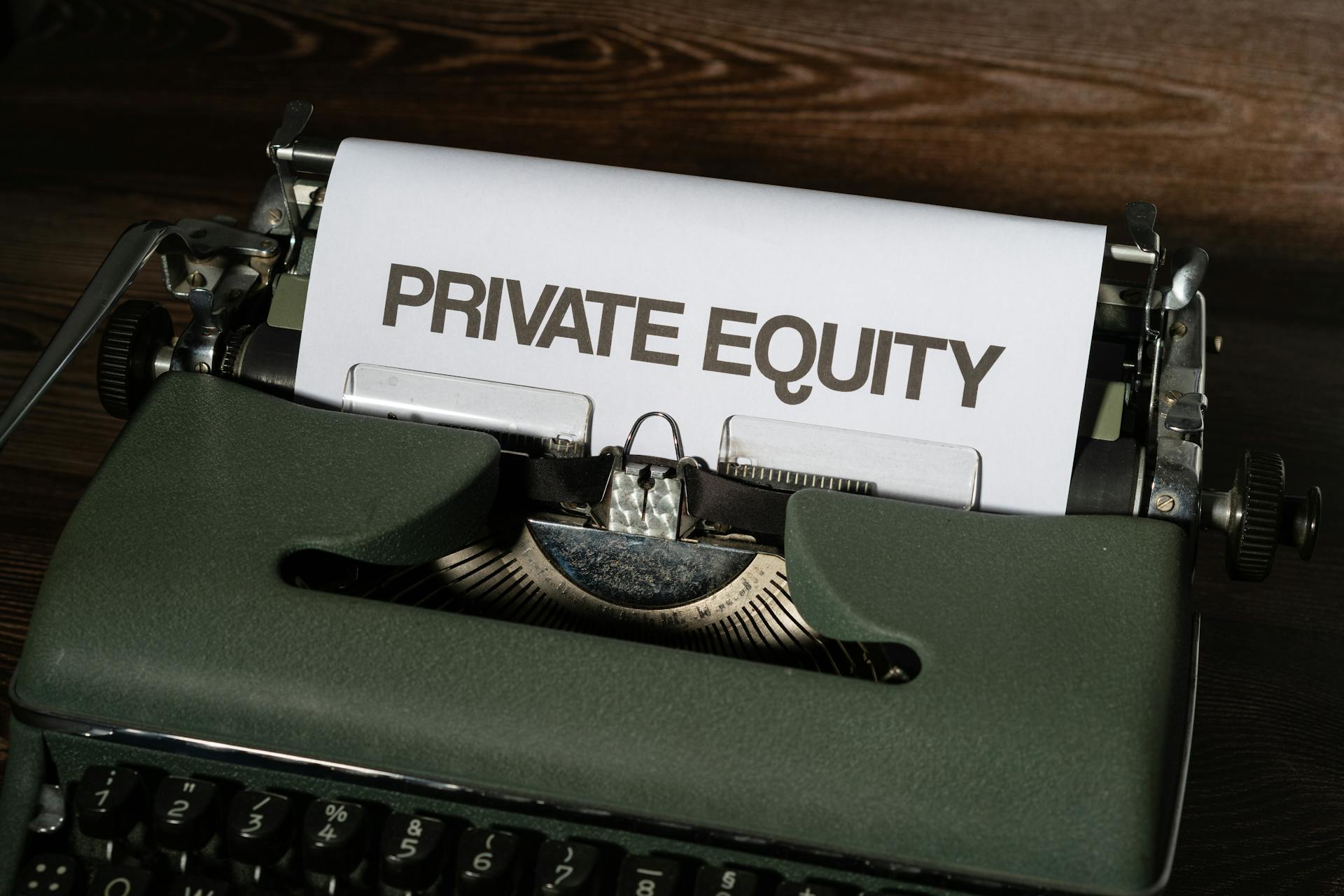
Preferred stock equity can be a valuable addition to your investment portfolio, but it's essential to consider a few key factors before investing.
The dividend rate is a crucial consideration, as it can range from 4% to 8% or more, depending on the specific investment.
Be sure to review the dividend payment schedule, as some preferred stocks pay dividends quarterly, while others pay annually.
A key benefit of preferred stock equity is its generally lower risk profile compared to common stock, making it a more stable option for conservative investors.
Typically, preferred stocks have a fixed dividend rate, which can provide a predictable return on investment.
Intriguing read: Do Index Funds Give Dividends
Investment Considerations
Investing in preferred stock equity requires careful consideration of several factors. It's a very personal decision that should be made only after fully understanding the risks and benefits of each investment option.
Deciding between preferred equity and common equity is a complex process that involves evaluating risk tolerance, investment goals, and diversification needs. Many successful investors choose to allocate capital to both depending on their individual circumstances.
Individuals interested in preferred stock equity should consult a professional financial advisor for guidance on risks, investment strategies, and tax considerations. This will help ensure that their investment decisions are informed and aligned with their overall financial goals.
Readers also liked: B Riley Preferred Stock
Ownership Interests Not Secured
Preferred equity holders don't have a claim against the underlying assets owned by the real estate entity or operating business.
In the event of a bankruptcy, preferred shareholders may not receive ownership in the real estate that is owned by the struggling entity.
Preferred equity holders are typically below debt holders on the capital structure, which means they shouldn't expect residual value to fall to them in the event of a bankruptcy or liquidation.
On a similar theme: Preferred Equity in Real Estate
Cumulative vs. Straight
Cumulative preferred stock is more desirable to investors because it requires the issuer to make up potentially skipped payments. This can be a significant difference, as seen in the example of ABC Company, where the cumulative preferred stock payout was $17 per share, compared to just $5 per share for the straight preferred stock.
In the case of straight preferred stock, the company is not required to make up past skipped dividends, only the current year's dividend. This means that if a company skips dividend payments for multiple years, the straight preferred stockholders will only receive the current year's payment.
You might like: Non Cumulative Preferred Stock
For instance, if ABC Company skips dividend payments in 2019 and 2020, and only pays 3% of their 5% dividend in 2021, the straight preferred stockholders will only receive the 2022 dividend payment of 5% ($5) before any dividend payments can be made to common stockholders.
In contrast, cumulative preferred stock ensures that all required payments are made to preferred stockholders first, before any dividend payments can be made to common stockholders. This is a significant benefit to investors, as seen in the example of ABC Company, where the cumulative preferred stock payout was $17 per share, compared to just $5 per share for the straight preferred stock.
Recommended read: Straight Preferred Stock
Callable
Callable investments can be a good option for those who want to access their money before a fixed investment period ends.
Callable bonds, for example, allow the issuer to redeem the bond before its maturity date, which can be a risk for investors.
Readers also liked: Callable Preferred Stock
This means that if the issuer calls the bond, you may lose out on potential returns that could have been earned if the bond had matured as planned.
Callable bonds often have a higher yield than non-callable bonds to compensate for this risk.
Investors should carefully consider their financial goals and risk tolerance before investing in callable bonds.
Callable options, on the other hand, give the holder the right to sell an underlying asset at a specified price, but the issuer can choose not to honor the option.
This can be a risk for investors, especially if the market value of the underlying asset has dropped.
Callable options often have a time limit, after which the option expires.
Investors should be aware of the potential risks and rewards before investing in callable options.
Here's an interesting read: Able Account Investment Options
Fixed-Income Payments
Preferred equity offers a predictable income source, making it a great option for those who rely on regular cash flow, such as retirees.
This predictability comes from the fixed dividend payments that preferred shares provide.
However, it's essential to remember that dividends are not guaranteed, and companies may reduce or suspend payments in times of financial trouble.
For example, if an investor purchases preferred equity with an annual dividend of $1.00 per share, they can count on receiving that payment, but there's no guarantee it will continue in the future.
Preferred equity investors may also receive an additional distribution to share in a percentage of the annual income, above a predetermined level, which can provide a boost to their returns.
However, this additional income is typically only available if the issuer's annual income exceeds a certain threshold, such as $1 million.
Explore further: Virtus Infracap U S Preferred Stock Etf
Proceeds to Each Investor
In a liquidity event, the proceeds to each investor depend on the type of preferred security issued. A participating preferred instrument, like in Scenario 1, can lead to significant dilution for common shareholders.

The Series A investor in Scenario 1 receives a preliminary liquidation preference of $10.0 million and then participates pro rata with the founder in the additional proceeds. This results in the Series A investor receiving 40% of the total proceeds, which is much greater than their 30% ownership interest.
In Scenario 2, the Series A investor receives a liquidation preference of $10.0 million and participates pro rata with the founder until they reach a maximum benefit of $25.0 million. At this point, the remaining amount is allocated 100% to the founder.
The Series A investor in Scenario 2 receives 35.7% of the total proceeds, compared to 40% in Scenario 1. This demonstrates that even with a capped participation feature, issuing preferred shares can still reduce the proceeds to common shareholders.
In Scenario 3, the Series A investor receives a liquidation preference of $10.0 million and no longer receives any proceeds, but can convert to common stock at a company value of $33.3 million. This means that the Series A investor receives the same payout if the company liquidates for $10.0 million or $33.3 million.
At any liquidation value above $33.3 million, the Series A investor would now be a common shareholder and receive 30% of all proceeds, maximizing their return. This highlights the importance of considering the conversion threshold when issuing preferred shares.
Readers also liked: Founder Preferred Stock
Preferred Stock Features
Preferred stock features are a crucial aspect to consider when investing in preferred stock equity. They can significantly impact the value of your investment and the returns you can expect.
The par value of preferred stock is typically $100 and never fluctuates, serving as a fixed reference point for dividend payments.
Preferred stock features can be beneficial to stockholders, making the stock more valuable and in higher demand, which results in higher market prices and lower yields.
On the other hand, features that benefit the issuer can be a risk to investors, resulting in lower market prices and higher yields.
Here are some key features to consider:
- Par value: $100
- Never fluctuates
- Dividend rate based on par
Conversion features, such as converting preferred stock to common stock, can be a significant advantage for investors, allowing them to participate in the company's success and potentially earning a higher return.
The conversion rate is typically negotiated at the time of investment and can be adjusted to prevent dilution of ownership.
Investment Returns
Preferred equity offers a steadier rate of return compared to common equity, making it attractive to institutional investors. This is because preferred shares are higher in the capital structure, ensuring that preferred shareholders receive dividend payments before common shareholders.
Preferred shareholders typically enjoy a larger dividend than common shareholders, with the dividend payments being less likely to be reduced or eliminated compared to common stock dividends. This provides a more stable source of income for investors.
For more insights, see: Investors Who Acquire Preferred Stock
Steady Rate of Return
Preferred equity offers a steadier rate of return compared to common equity shares. This is because preferred shares are higher in the capital structure, meaning preferred shareholders receive dividend payments before common shareholders.
Preferred equity shareholders typically enjoy a larger dividend than common shareholders. For example, an investor may purchase preferred equity that entitles her to an annual dividend of $1.00 per share.
This steadier rate of return is attractive to many investors, especially institutional investors. They can rely on the predictable income from preferred equity.
Preferred shareholders are also less likely to have their dividends reduced or eliminated compared to common stock dividends. This provides a sense of security for investors who prioritize steady returns.
For another approach, see: How Do Angel Investors Make Money
Investors Receive a Percentage of Annual Income
Investors who purchase participating preferred equity can receive a percentage of the issuer's annual income, in addition to a scheduled dividend.
This additional distribution is usually triggered when the company's annual income exceeds a predetermined level, such as $1 million.
For example, if an investor owns 5% of the total outstanding participating preferred equity, they may be entitled to share in 5% of the annual income above $1 million.
The percentage of annual income received by participating preferred shareholders is usually proportional to their stake in the company.
This unique feature can provide a steadier rate of return, making preferred equity more attractive to some investors.
For your interest: Do Angel Investors Get Equity
Stock Advantages and Disadvantages
Preferred stock equity can be a solid investment option for those looking for a steady income stream and a lower risk profile. Preferred equity holders are typically senior to common equity holders in the capital stack, meaning they receive payouts before common equity holders in the event of default or bankruptcy.
If this caught your attention, see: Preferred Stock Holders
One of the most appealing features of preferred stock is its fixed-income payments, which provide a steady income stream to investors. These payments are typically higher and more regular than common stock, making them attractive to investors seeking a reliable source of income.
Preferred shareholders have the advantage of receiving dividend payouts before common stockholders. If a company limits or omits dividends, common shareholders will feel the impact before preferred shareholders. This priority in dividend payouts is a significant advantage of preferred stock.
However, preferred stockholders usually lack voting rights in the company, which means they have no say in corporate decisions. This is in contrast to common stockholders, who typically do have such rights.
Preferred stocks usually offer less potential for capital appreciation than common stocks, with a lower capital gain potential. Their price doesn’t fluctuate as much, which limits the potential for large price gains.
Here are some key advantages and disadvantages of preferred stock equity:
Overall, preferred stock equity can be a good option for investors seeking a steady income stream and a lower risk profile. However, it's essential to understand the potential drawbacks, including the lack of voting rights and lower capital gain potential.
A unique perspective: No Load Mutual Funds May Have Lower Expense Ratios
Investment Process and Costs
Investing for preferred stock equity requires considering the cost of preferred stock. This cost represents the annual amount a company pays out in dividends divided by the total money it receives from issuing the stock.
Management often uses this cost to determine the most effective and economical capital-raising method. Companies have various options to fund expansions or maintain operations, such as issuing debt, common shares, or preferred shares.
To calculate the cost of preferred stock, you divide the yearly dividends paid on these shares by their current market price. This rate is crucial in comparing it to other financing methods.
The cost of preferred stock is essentially the dividend yield on a company's issued preferred shares. It's calculated by dividing the preferred stock dividend per share (DPS) by the price at which the shares were issued.
Expand your knowledge: Large Company Growth Index Fund
Accelerate Cash Flow
Preferred equity typically has a higher dividend yield compared to common equity.
This means investors receive more cash flow earlier in the life of the investment, which can be a significant advantage.
Preferred equity holders are free to reinvest this cash flow into any investment opportunities as they see fit.
Preferred equity can be a source of significant cash flow, especially when purchased in large quantities, as is sometimes the case with institutional investors.
Worth a look: Free Cash Flow Etfs
Settlement
Settlement is a crucial aspect of buying and selling preferred stock. Regular way trades settle in one business day (T+1).
The settlement timeframe for preferred stock is the same as common stock. This means that if you buy or sell shares of preferred stock, the transaction will be settled the next business day.
If you're selling shares of preferred stock, you'll need to have them in your account by the settlement date. This ensures a smooth transfer of ownership.
Regular way trades settle in one business day (T+1), while cash settlement trades settle the same day (as long as before 2:30pm ET).
Here are some key facts to keep in mind:
- Discount = trading below par
- Premium = trading above par
Calculating Stock Costs
Calculating Stock Costs is a crucial step in understanding the true value of an investment. The cost of preferred stock, in particular, can be a bit tricky to grasp.
The cost of preferred stock is essentially the expense a company incurs in exchange for the capital raised from selling these shares. It's calculated by dividing the yearly dividends paid on these shares by their current market price.
Companies often refer to this cost to determine the most effective and economical capital-raising method. They have various options to fund expansions or maintain operations, such as issuing debt, common shares, or preferred shares.
To find the cost of preferred stock, you divide the yearly dividends paid on these shares by their current market price. This rate is crucial in comparing it to other financing methods.
The cost is also crucial in calculating the company's Weighted Average Cost of Capital. It's a key factor in determining the overall cost of capital for the company.
To calculate the cost of preferred stock, you divide the preferred stock dividend per share (DPS) by the price at which the shares were issued. This formula is straightforward: Rp = D (dividend)/ P0 (price).
For example, if a company offers a preferred stock that pays an annual dividend of $4 and the current share price is $25, the preferred stock cost would be $4 ÷ $25.
Expand your knowledge: Share Price Tips Industries
Frequently Asked Questions
What is the most important priority an investor in preferred stock?
Preferred stock investors have priority access to a company's income, receiving dividends before common stock shareholders. This priority ensures a stable return on investment for preferred stockholders.
What are the benefits of investing in preferred stock?
Preferred stock offers higher yields and greater stability compared to common stock, making it a suitable option for income-focused investors. It also provides some downside protection in the event of a company's liquidation.
What are the risks of investing in preferred stocks?
Investing in preferred stocks carries the risk of low liquidity, making it difficult to sell shares quickly, and potentially resulting in lower sale prices due to wide bid-ask spreads. This can lead to losses if you need to sell your shares in a hurry.
Sources
- https://app.achievable.me/study/finra-series-65/learn/investment-vehicle-characteristics-equity-preferred-stock
- https://blog.intrepidcapitalfunds.com/advisor-insights/preferred-stocks-potential-hidden-yield-gems
- https://fnrpusa.com/blog/preferred-equity-vs-common-equity-commercial-real-estate/
- https://www.pcecompanies.com/resources/things-to-consider-in-a-preferred-stock-capital-raise
- https://educounting.com/cost-of-preferred-stock/
Featured Images: pexels.com


